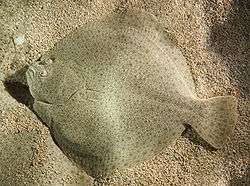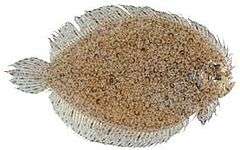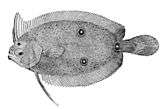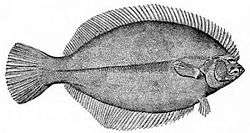Turbot
| Turbot | |
|---|---|
 | |
| Scophthalmus maximus | |
| Scientific classification | |
| Kingdom: | Animalia |
| Phylum: | Chordata |
| Class: | Actinopterygii |
| Order: | Pleuronectiformes |
| Family: | Scophthalmidae |
| Genus: | Scophthalmus |
| Species: | S. maximus |
| Binomial name | |
| Scophthalmus maximus (Linnaeus, 1758) | |
| Synonyms | |
| |
The turbot (Scophthalmus maximus) is a species of flatfish in the family Scophthalmidae. It is a demersal fish native to marine or brackish waters of the North Atlantic, Baltic Sea and the Mediterranean Sea.
Etymology
The word comes from the Old French tourbout, which in turn is thought to be a derivative of the Latin turbo ("spinning top") a possible reference to its shape.[1] Another possible origin of the Old French word is from Old Swedish törnbut, from törn "thorn" + -but "stump, butt, flatfish", which may also be a reference to its shape (compare native English halibut).[2] Early reference to the turbot can be found in a satirical poem (The Emperor's Fish) by Juvenal, a Roman poet of the late 1st and early 2nd centuries A.D., suggesting this fish was a delicacy in the Roman empire.
In the US, UK and English-speaking Canada, turbot is pronounced /ˈtɜːrbət/ TUR-bət.[3] The French pronunciation of "turbot" is [tyʁbo].
In Turkey, where the fish is popular and expensive, it is called "Kalkan"—"shield"—from the fish's resemblance to the item. Instead of a smooth skin, Kalkan (Scophthalmus maeoticus), which is from the Black Sea, has small spikes on both sides; it is considered a subspecies of the Mediterranean turbot (Scophthalmus maximus).
Description
The turbot (Scophthalmus maximus) is a large left-eyed flatfish found primarily close to shore in sandy shallow waters throughout the Mediterranean, the Baltic Sea, the Black Sea and the North Atlantic. The European turbot has an asymmetrical disk-shaped body, and has been known to grow up to 100 cm (39 in) long and 25 kg (55 lb) in weight.[4][5] The turbot is also commonly known in a certain part of Greystones, Dublin as the King's fish.
Fisheries
Turbot is highly prized as a food fish for its delicate flavour, and is also known as brat, breet, britt or butt. It is a valuable commercial species, acquired through aquaculture and trawling. Turbot are farmed in Bulgaria, France, Spain, Portugal, Romania, Turkey, Chile, Norway, and China.[6] Turbot has a bright white flesh that retains this appearance when cooked. Like all flatfish, turbot yields four fillets with meatier topside portions that may be baked, poached, steamed, or pan-fried.
See also
References
- ↑ Oxford English Dictionary, Turbot
- ↑ "turbot". Online Etymology Dictionary.
- ↑ http://dictionary.reference.com/browse/turbot
- ↑ Froese, Rainer and Pauly, Daniel, eds. (2009). "Psetta maxima" in FishBase. November 2009 version.
- ↑
 Chisholm, Hugh, ed. (1911). "Turbot". Encyclopædia Britannica. 27 (11th ed.). Cambridge University Press.
Chisholm, Hugh, ed. (1911). "Turbot". Encyclopædia Britannica. 27 (11th ed.). Cambridge University Press. - ↑ Psetta Maxima Seafood Portal
External links
| Look up turbot in Wiktionary, the free dictionary. |
| Wikispecies has information related to: Scophthalmus maximus |




.png)
